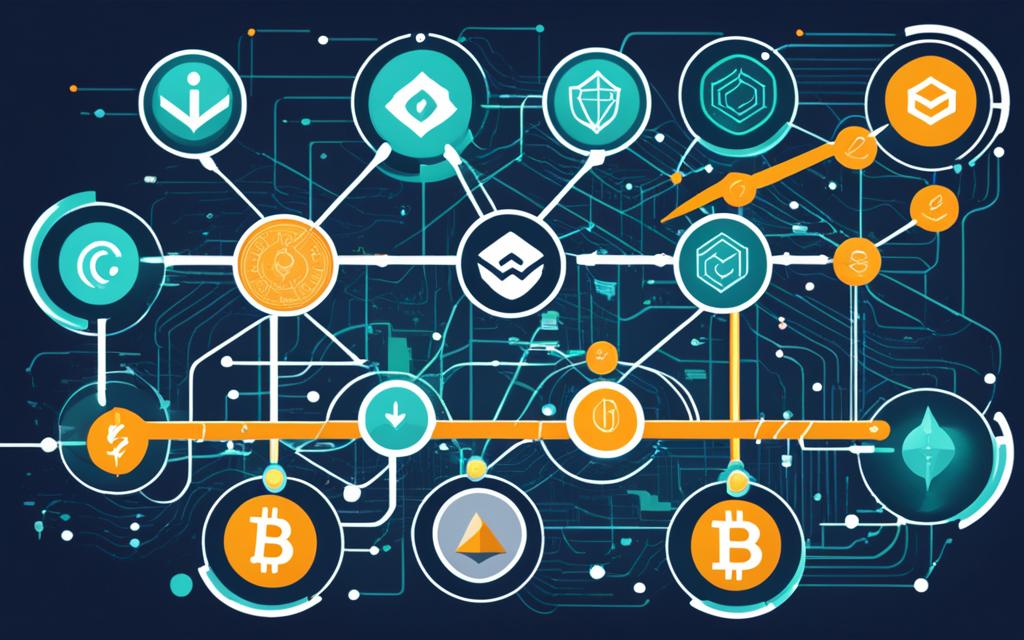Table of Contents
Cryptocurrency forensics track financial deals on the blockchain. They help spot wrongdoers and find digital funds. This is vital in many legal settings like court cases, bankruptcy, and criminal law, to name a few. It’s often used to help those hit by online scams, thefts, and hacks.
Key Takeaways:
- In legal matters, tracing funds and finding the guilty is key, thanks to cryptocurrency forensics.
- It’s a major tool for getting justice in crimes like online scams and thefts.
- Helps in many legal areas, ensuring financial crimes are answered for.
- It makes the digital money world more honest and clear.
- With tech tools, detectives can look at behaviours, follow money trails, and find proof for crimes.
As more people use cryptocurrency, it’s more important than ever to fight fraud and theft. Crypto forensics helps find hidden links, track money, and collect legal evidence.
Experts use special software and platforms for this, like BAD, BitRank, and more. These tools can look at blockchain data and find connections, even when money mixing services are used.
They focus on crimes using money, fraud, and cyber attacks. Techniques like spot-checking transactions and joining addresses can find illegal money moving around1.
In the crypto world, following the various money rules is a big deal. Companies check IDs and watch transactions closely to stop fraud. They are always wary of big or risky money moves2.
New tech, like AI, is making it easier to catch money crimes. These tools help experts find and understand illegal money trails better2.
People in the crypto field, laws folks, and police are starting to work more together. This teamwork will make following money rules smoother and make crypto safer2.
Understanding Cryptocurrency Forensics and Asset Tracing
The rise of cryptocurrencies has posed new challenges for those in the financial world. Experts use tools like cryptocurrency forensics and asset tracing to fight against digital financial crimes. They dive into blockchain transactions to find evidence.
Unmasking the Anonymity
Users in cryptocurrency transactions remain mostly anonymous, known only by their addresses. Investigators use smart techniques and know-how to find out who’s behind these transactions. This lets them link these digital dealings to real people or groups involved in shady practices3.
The Power of Data Analysis
Data analysis is key in this field. By looking at the data, investigators can find who’s hiding behind these transactions. They can spot connections to frauds and even see the steps crooks take to hide their money3. Special tools help turn heaps of transaction data into easy-to-follow maps. These maps can show how money is moved around, possibly helping to identify wrongdoers by patterns in their financial behaviour4.
Special techniques can group together addresses controlled by the same person. This helps lift the veil of anonymity and trace assets effectively4.
Intelligence Gathering
Getting key info is crucial in this line of work. Investigators can pull data from various digital sources by the legal use of subpoenas. This approach gives them access to who owns certain addresses or their banking details. With this info, they can start connecting the dots between financial activities and the individuals or groups involved4.
Identifying High-Value Targets
Certain cryptocurrency addresses hold a lot of value, which can be a treasure trove for fraud victims. Agencies can aim to seize or freeze these assets. Doing so might help the victims recover their losses4. By monitoring these ‘wealthy’ addresses, investigators can gauge the seriousness of a fraud and get the law enforcement involved. This can lead to legal actions that might help many victims at once4.
Automated Tools and Risk Profiling
To tackle the fast-changing crypto world, investigators use smart software. This software looks at the risk of certain transactions. With this knowledge, investigators can focus on the deals that might pose the biggest problems4.
Location Tracking and Metadata
System that keep an eye on the blockchain are essential. They collect extra info about transactions, like IP addresses. This data can sometimes point to places where certain crypto activities happen4.
This geolocation info is vital. It helps connect the digital trail to the real world. This can be really useful in figuring out who’s behind certain financial crimes4.
Enhancing Security and Preventing Scams
Teaching about crypto safety is as important as investigating crimes. To stay safe, people need to protect their crypto wallets. The right tools and knowledge can help prevent fraud and money theft5.
Knowing about the common scams is also key. By being aware of these dangers, you help make the digital world a safer place for everyone5.
Experts in cryptocurrency forensics are essential. They combine their analytical skills with know-how in regulations and blockchain. This boots their efforts in fighting financial crimes, recovering assets, and keeping the digital financial world safe5.
Tracing Cryptocurrency Transactions
Cryptocurrencies are not fully anonymous as many think. For instance, Bitcoin’s transactions are open on blockchain ledgers online. Financial investigations and agencies employ ways to make these transactions less anonymous. They use tools to look into the ownership of coins and transactions to find links with illegal activities.
As cryptos grow in use for crimes, special tools and tech for tracking them are being made. For example, TRM Labs offers tools for tracking crypto dealings to spot bad actors early, enhancing safety.
These tools can automatically find odd money movements. By spotting these, they help track and reduce crimes like fraud. This is key in the fight against illegal money use online.
Moreover, these tools link info not directly on blockchains, broadening the view of transactions. This means investigators can check more sources while understanding how and where money moves.
Linking funds across various blockchains is streamlined by these tools. This is crucial with more types of blockchains used today. It makes investigations sharper and more efficient.
These platforms also offer tools to sort data better. With tools like Fingerprint Explorer and Graph customizations, investigation becomes easier. This leads to quicker and richer insights for stopping financial crimes.
Cryptocurrency forensic tools, like TRM Labs, are well-appreciated by those who use them. They get a high rating, showing they make a big difference in solving crimes. They also make sure its very secure for users, with regular checks to meet top standards. They provide global support, helping investigators anytime6.
Investigating crypto transactions is essential in fighting crimes online. Progress in tracking tech and the skills of experts helps reveal hidden money trails. This is key in stopping criminal activities and keeping digital currencies safe for everyone7.
| Statistics | Data Source |
|---|---|
| Over $20 billion estimated to be laundered through the blockchain in 2022, reflecting a 68 percent increase from the previous year | Link 2 |
| Most transactions today occur on protocols like Ethereum, rather than with Bitcoin, showcasing a shift in blockchain usage trends | Link 2 |
| The US Treasury sanctioned Tornado Cash, a popular mixer, in 2022, demonstrating tough regulatory stances towards privacy tools in modern blockchains | Link 2 |
| Investigators noted an increasing complexity in blockchain forensics due to the convergence of financial crime and cybersecurity, highlighting intertwined challenges | Link 2 |
Blockchain analysis is key in stopping theft and detecting laundering. It’s also vital for making sure companies obey laws and preventing fraud in ICOs8. Tools from companies like Chainalysis and TRM Labs support these efforts. They help track transactions and make sure everything is done legally8.
Apps like BlockSci also aid in investigations by offering analysis tools. They support those looking into crimes while pushing for best practices8.

Emerging Challenges and Future Outlook
Crypto is changing, and so are the challenges in tracking it. Coins focusing on privacy challenge detection efforts. Also, laws and crime are getting more tangled, needing better tools to keep up7.
Still, successes in catching crypto criminals offer lessons. These improve how we track coins and fight crime. They help us get better in an ever-evolving crypto world.
Tracing crypto transactions is vital for cracking financial crimes in the digital world. Advanced tools empower investigators to spot illicit transactions and see the money flow. Working together, we can make cryptocurrencies safer and stop those who abuse them. With ongoing improvements, we can ensure digital transactions are secure and honest7.
Investigating Cryptocurrency Addresses and Clusters
Cryptocurrency forensic investigations look into who owns what in the digital world. They focus on linking addresses, dealing with fraudsters, and tracking money9. Special tools piece together the story hidden in the blockchain, unmasking wrongdoers and following the cash. With these tools, we turn transactions into easy-to-read maps, spot trends, and track the money trail. This work is key in finding out if certain addresses are holding lots of valuable digital coins9.
DataWalk is a standout tool for spotting the baddies in the crypto world10. It brings together different tools and sources, helping to find clues that could get missed otherwise10. By combining blockchain info with data from places like Coinfirm, DataWalk makes it easier to keep tabs on crypto money movements. It also lets users make sense of these flows, which is critical in pinpointing dodgy money and the groups linked to it10.
But, getting to the bottom of crypto crime is tough. Most investigators feel they don’t have the right gear for the job11. The usual detective stuff might not be enough to tackle the complex world of blockchain11. Plus, crooks can use special services to hide dirty money trails in crypto deals11. Thankfully, there are tools to help peel back these hidden layers and spot the shady deals. Looking at the blockchain itself really helps uncover illegal money schemes and other foul play11.
To sum up, getting to the bottom of cryptocurrency crimes needs some serious tech and smart analysis9. Tools like DataWalk are great for spotting the culprits and making investigations more efficient10. Still, privacy-minded cryptos make the chase harder, demanding even more advanced tools11.
Utilizing Subpoena Targets in Investigations
During cryptocurrency forensic work, reaching out to subpoena targets is key. These can be commercial exchanges or finance firms and service providers. They follow rules like KYC and AML. This lets investigators get data and check who’s really behind crypto deals12.
Subpoenas help gather personal info on crypto owners and their accounts. This info is vital for spotting illegal activities in the crypto world. It also helps track money movements and understand who’s doing what12.
Given the complex nature of crypto, investigators need to know a lot about it. They must understand different crypto like coins, tokens, and NFTs. Each type needs its approach for review and understanding12.
Cryptocurrencies offer privacy but investigators find ways to reveal identities. They look at things like social media or check if rules were followed. Blockchain examinations and other tools help them discover who’s behind these accounts12.
While block explorers help find crypto deals on the blockchain, they might not tell the whole story. To get more, investigators often ask for extra data from exchange companies or OTC desks12.
Exploring blockchains without the right tools can be hard. Using blockchain nodes or special data services helps. This ensures investigators can check everything they need to thoroughly12.
Looking into records from exchanges, OTC desks, and other places is also important. These records show buy, sell, and transfer actions. This data is vital for finding links between transactions and spotting any illegal intentions12.
With the info from subpoena targets, investigations get a boost. This leads to better, quicker results in the world of cryptocurrency detectives12.
Assessing Current/Historical Value and Total Transactions
Examining the worth of cryptocurrency addresses is key in investigations. These addresses are vital for finding money and during legal actions13. Also, looking at how much cryptocurrency moves can show how big frauds are and how many people they affect14.
Cryptocurrencies are quick and cheap for transactions, compared to bank transfers13. For example, the Bitcoin blockchain has seen almost a billion transactions. But, this has also made it more appealing to criminals15.
Law enforcement uses tools to follow the money and link transactions to real people13. This makes it easier for teams to work together to stop crime faster13. Analyzing transaction patterns can spot wrongdoings early, protecting people from scams13 and flagging dodgy deals better14.
It’s important for agencies to share what they know to fight crypto crime well13. With the right skills and help, they can take back stolen money with legal actions13.
Example: The Impact of Large-scale Fraud Schemes
Massive frauds with cryptocurrencies can lead to big problems for a lot of people. In 2023, over $22 billion worth of crypto was used in illegal money movements13. These actions show how large frauds can be and why we need strong detective work to help the victims.
These crimes might lead to group lawsuits, helping many victims take action13. Looking at the number of transactions can tell us a lot about the size of the problem. It helps police and lawyers make plans to get money back.Click here for related article.
The picture above shows how many cryptocurrency transactions are out there. Analyzing this data with the right tools can help us follow the money. It supports efforts to recover funds in fraud cases14.
Analyzing Risk Profiling and IP Addresses
Cryptocurrency forensic investigations use risk profiling to track activity and link them to known groups. They look at IP addresses connected to specific transactions11. Systems watching the blockchain pick up private info like IP addresses. These details can tell us where someone was when they made a transaction. This work is important in investigations11.
“Nearly 74% of agencies feel under-equipped for crypto investigations, highlighting a significant challenge in addressing illicit activities through cryptocurrencies”11.
Risk profiling is key in spotting threats and shady transactions in crypto. By looking at how transactions are done, experts can see how risky they are. This helps focus their work better11.
An important part of this is checking the IP addresses in crypto deals. These addresses can give a lot away about a person’s location and who they might be11.
“Criminals can exploit the lack of geographical boundaries in blockchain transactions to evade detection and prosecution”11.
Looking at IP addresses can reveal where crypto transactions started. This is crucial in following the money and linking people to dodgy deals11.
Moreover, combining analysis of blockchain actions with other data, like IP addresses and social media hints, paints a full picture. It helps build a better profile of those up to no good11.
“Integration of on-chain analysis with off-chain data sources, such as tracking IP addresses and social media profiles, helps create a comprehensive profile of individuals involved in illicit activities”11.
New blockchain tools are making IP address sleuthing easier. They let investigators dig deep into hidden connections and track crypto transactions. These tools are crucial in the fight against financial crimes16.
Overall, risk profiling and IP address digging are vital in tracing cryptocurrency crime. Using this knowledge, investigators can better catch and stop those breaking the law1116.
Investigating Cryptocurrency Theft and Fraud Schemes
Cryptocurrency forensic investigations are important. They help uncover and deal with theft and fraud. Different techniques are used to find evidence and track transactions. This helps lessen the negative effects of fraud17.
Understanding the Investigation Process
The process starts with a close look at what happened. This includes looking at financial records and blockchain transactions. The aim is to find patterns and spot who might be involved17.
One challenge is the hidden identity in blockchain transactions. This makes it hard to know who’s really involved. Yet, with advanced methods and help from experts, investigators can do better at finding and stopping those responsible18.
Utilizing Digital Forensics and Specialized Investigation Services
Investigators use digital forensics to follow the stolen money. They check emails, investigate servers, and look at where IP addresses are located17.
They also rely on help from companies like Bitquery and Chainalysis. These firms provide tools and knowledge for safe blockchain use. They help businesses, banks, and the police prevent crimes and check risks18.
Tracking Illicit Transactions and Fraudulent Schemes
To fight fraud, investigators use special tools for blockchain. These tools can find and stop illegal money movements. By tracking transactions, they learn more about where the stolen money goes and who’s behind it18.
Risks and Challenges in Cryptocurrency Fraud Investigations
Cryptocurrency fraud brings its own set of problems. For example, some scams trick people into investing a lot of money. There’s also threats like hacked wallets, investment tricks, and scams that hurt trust in digital money platforms19.
Collaborative Efforts for Effective Investigations
To deal with cryptocurrency fraud, many groups work together. This includes teams specialised in checking blockchains and keeping them secure. They help find stolen money, do investigations, and give advice18.
Working with these experts boosts the chances of solving cases. It helps get back stolen money and punish those at fault.
| Service Provider | Specialization | Accepted Payment Methods |
|---|---|---|
| Bitquery | Investigation services across 40+ chains with Coinpath® MoneyFlow tool | Not specified |
| Chainalysis | Anti-money laundering (AML) and compliance solutions | Not specified |
| CipherTrace | Blockchain security, tracing illicit transactions, identifying high-risk addresses | Not specified |
| Elliptic | Blockchain analytics to detect and prevent illicit activities | Not specified |
| Coinfirm | Risk assessment and compliance tools | Not specified |
The Role of Cryptocurrency Forensics in Legal Proceedings
The field of cryptocurrency forensics is vital for legal cases, offering key insights and proof to investigators, lawyers, and the police. These experts use advanced methods to make sure legal cases are effective and help out with criminal complaints and when law enforcement works together. This all helps make sure legal cases end well.
Looking into cryptocurrencies needs close attention and detailed study. One method, blockchain forensics, tracks the public record of crypto deals. This helps investigators follow illegal actions and spot money laundering methods. It forms a strong base for making criminal complaints20.
High-profile cases have recently shown how crucial cryptocurrency forensics is. Take the case of Roman Sterlingov, who ran Bitcoin Fog. This was a big tool for turning dirty bitcoins into clean ones. By looking at blockchain transactions, Chainalysis proved his involvement in money laundering. This shows the power of blockchain forensics20.
Crime agencies see crypto mixers, like Bitcoin Fog, as big security threats. So, they’ve stopped these services, showing how important it is to have great forensic methods. This helps reveal and stop illegal activities in the crypto world20.
Blockchain forensics is also great for finding out who’s behind criminal activities and tracing stolen money. Experts have found new ways to connect crypto wallets and find joint ownership. This has made it much better to find and get back stolen money in court cases20.
Yet, whether blockchain forensics evidence can be trusted has caused debate. In the Sterlingov case, this evidence was questioned. But the judge accepted it as true and a reliable source. This ruling paves the way for more use of blockchain forensics in legal cases20.
Chainalysis, a top firm in blockchain forensics, has been key in many big cases. Their tools speed up blockchain checks, giving vital proof for legal cases. After the Sterlingov case, the CEO said their way of working has been acknowledged as the best for analyzing blockchains and proving cases20.
To use cryptocurrency forensics well, all involved need to work closely together. They do in-depth background checks on those involved, looking into any past crimes or frauds. This kind of caution helps build a strong case and ensures legal cases turn out well20.
Using cryptocurrency forensics in the law shows the growing need for experts in finance who understand digital money. More people are signing up for courses like the Certified Crypto Investigator™ (CCI). This shows everyone is starting to see how important skilled people are in this area. Their knowledge in forensic work makes legal cases and getting back money smoother, protecting the financial system21.
Understanding Cryptocurrency Forensic Education
Cryptocurrency forensic education is very important for experts in the field. They learn about financial crimes, how to investigate cryptocurrency, and looking into blockchain. These experts might speak in court about their discoveries. It’s crucial for them to keep learning to understand the changes in cryptocurrency.
Stats show the Certified Cryptocurrency Forensic Investigator course costs $997.00 USD. A discount is available, bringing the cost to $1,547.00 USD, saving 35%22. This program offers full access to learning at your own pace, with real-world examples, and practical tasks. There’s also support from instructors live from 9:00 am to 9:00 pm CST. It helps improve your career by making you a pro in cryptocurrency investigations. Plus, you can get your money back if you’re not happy within 30 days. The course is quick to finish, making it ideal for busy people. It’s also recognised nationally, showing it’s high quality22.
Price for the on-demand certification starts at $1,100 for one person. For groups, it’s $1,000 per student23. Specialized former U.S. Secret Service agents and FBI analysts teach this course. It includes 14 hours of training and a completion exam. You get access to all materials through the learning platform, which stays available. Passing the exam gets you a certification and badge23.
The cryptocurrency world brings new risks as it grows, showing why we need to learn about it. Theft of cryptocurrency wallets can happen in many ways, like by stealing online keys. Scams are common, tricking people into fake investments or romance deceptions. Staying educated helps experts protect people and stop cybercrimes24.
The Evolution and Importance of Blockchain Forensics
Blockchain forensics is key in digital investigations today. It helps find out about complex transactions and spot illegal actions on the blockchain. This is important due to the growth of blockchain tech and digital currencies. The focus on clear, traceable records is crucial. It lets investigators and the police track and look into transactions. This gives them useful details about criminal activities.
Over time, many tools have been made to help with blockchain forensics. For example, Chainalysis25 is a leading software. It’s used for deep investigations. Elliptic25 is great at finding illegal actions online. It uses smart tech. CipherTrace25 is another important tool. It can track more than 800 types of digital cash. This makes it good for spotting dodgy deals. Crystal Blockchain25 adds smart insights about Bitcoin and Ethereum. Meanwhile, Scorechain25 checks the risk and compliance of many digital coins. Then, there’s BlockSeer25. It helps create visuals of Bitcoin and Ethereum transactions. And BlockSci25 is free to use. It offers in-depth looks into blockchain data. WalletExplorer25 helps find out who owns different wallets.
Blockchain forensics is changing how we investigate finances. Illicit transactions are harder to hide thanks to digital currencies. Blockchain tools are vital for the police. They help find and stop criminals online26. By tracing the money, they can connect different digital wallets. This shines a light on illegal actions.
But, working in blockchain forensics can be tough. There’s a lot of data to handle. Plus, making sense of it all can be a challenge26. The fact that users can be anonymous makes things harder. It needs special methods to connect transactions. And because the blockchain is worldwide, laws from different countries can get in the way. Blockchain tech is always changing, too. So, forensic methods need to keep up26.
So, what’s next for blockchain forensics? It could use AI and machine learning to get even better26. These techs can help spot small details in big datasets. And working together is key. The police, blockchain experts, and regulators need to share knowledge. This will help push blockchain forensics forward26.
As researchers dig deeper, they find key clues in digital investigations. Things like transaction records, wallet details, and more are crucial26. Using lots of tools, they pick apart these clues. This helps build strong cases against wrongdoers.
In summary, blockchain forensics has evolved a lot. It’s now essential for uncovering hidden money trails and fighting crimes. As blockchain and digital money grow, clear records are more important than ever. Thanks to new tech and teamwork, we’re better at investigating online activities. Blockchain forensics is a vital part of digital detective work. By keeping up with tech changes and sharing knowledge, it’ll keep making a big difference27.
Conclusion
Cryptocurrency and blockchain forensics are now key in handling cases with online money. They help find who’s behind a crime, track money, and give proof in court. As scams with online money get more tricky and new digital coins come out, these tools are vital.
28Many places are working hard together to get better at studying digital money. They aim to find hidden money, take it from wrongdoers, use it in court, and then dispose of it properly. This teamwork fights crime and keeps digital money safe.
In the world of online money, things change fast. There are more than 1,600 types of digital coins out there, with just the top three making up most of the market29. These transactions are seen as items, not cash, by tax offices. This means gains or losses from online money must be noted on tax forms29.
New ways to find those who try to hide their online money and the use of smart computer tools will make finding criminals easier30. It’s really important for people working in this area to keep learning about the newest tools and methods. This is where training like the Certified Crypto InvestigatorTM (CCI) program comes in, showing how crucial it is to keep updated.
FAQ
What is cryptocurrency forensics?
Cryptocurrency forensics is a way to investigate and track digital financial transactions. It aims to find and trace digital assets. It’s very important in legal cases, like in court, for crimes, when someone goes bankrupt, or when rules are broken. It helps find money.
What is asset tracing in cryptocurrency?
Asset tracing in cryptocurrency finds digital money by following transactions. It’s used in many legal situations and to find wrongdoers. This method works in both crime and business cases.
Are cryptocurrencies completely anonymous?
No, cryptocurrencies aren’t fully anonymous. Bitcoin and others leave a public record of transactions. Cops and money experts can figure out who’s who.
How do cryptocurrency forensics de-anonymize transactions?
Experts use special tools to study blockchain and figure out who owns what. They look at how money moves and who’s spending it. This helps find financial criminals.
Who are subpoena targets in cryptocurrency forensic investigations?
When investigating, legal orders might target places where cryptocurrencies are handled. These include official exchanges and other key services. They help link the money to real people.
How is the value of cryptocurrency addresses assessed?
The value of a digital address is based on how much money has gone through it. Big amounts mean big crimes or losses. This helps in legal action to recover the money.
What is risk profiling in cryptocurrency forensic investigations?
Risk profiling is about spotting suspicious activity and people through their online actions. It looks at where transactions come from. This tells a lot about who’s behind them.
What is the role of cryptocurrency forensics in investigating theft and fraud schemes?
It plays a big part in finding out about theft and scams involving digital money. Experts look at how transactions happened, dig through blockchain data, and follow the digital clues. They might need to get extra information legally to catch the bad guys.
How does cryptocurrency forensics support legal proceedings?
It helps lawyers by checking important financial records, getting ready for trials, and working with police. Investigators also learn a lot about the people linked to court cases. Everyone has to work together for it to succeed.
Why is cryptocurrency forensic education important?
Learning about cryptocurrency investigations is key for experts in this area. Training teaches them how to track crimes and understand digital money movements. They help in court with their skills and knowledge.
How has blockchain forensics evolved?
Blockchain investigations have become a must for following digital money trails. They help in court to prove who did what with the money. Blockchain’s unique records make it easier to track crimes.
What is the importance of cryptocurrency forensics in legal investigations?
Forensics in this area is super important for solving financial crimes. It helps pinpoint the bad guys, follow the money, and get the proof for court. With more crimes using digital money, this kind of work is needed more than ever. Teamwork is crucial for success in these cases.












